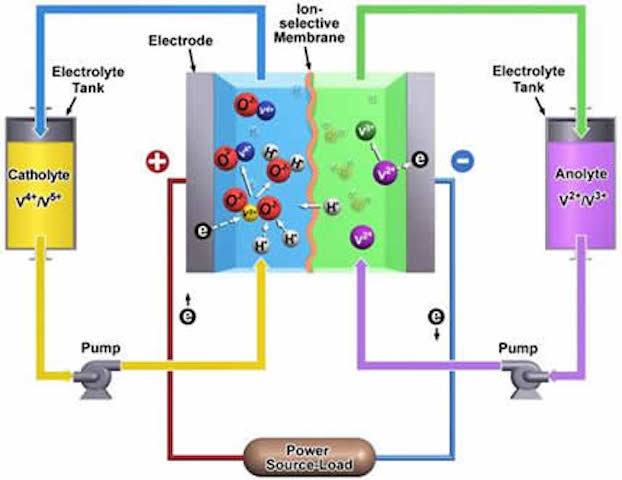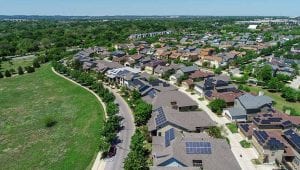Three Washington State utilities with big investments in wind power have just signed on to a new $14.3 million energy storage and smart grid demonstration project. The end payoff will be further proof that wind power and other intermittent forms of energy can be integrated into a utility scale electricity provider while keeping up a steady stream of reliable, durable power.
The news comes fresh on the heels of an announcement by Siemens, which has just hit the 10-gigawatt milestone for its wind power installations in the Americas. Considering the vast, as yet untapped offshore wind power resources in the US there’s plenty more where that came from.

We Built These Energy Storage Demo Projects!
The new three-utility energy storage project is being spearheaded by our friends over at Pacific Northwest National Laboratory, which developed the vanadium flow batteries that will be used by two of the utilities. The $14.3 mil is being chipped in by Washington State, so group hug all you taxpayers out there.
Here’s the rundown on the three (for easy reference the links go to their wind power pages):
1. Avista Utilities will get $3.2 million for a project that combines a flow battery with a “smart campus” at Washington State University in Pullman. The utility will deploy its experience with smart grid tech funded in part by the US Department of Energy’s Smart Grid Investment program.
2. Puget Sound Energy gets $3.8 million for a lithium-ion battery project designed to provide some cost-benefit numbers for different sites in the utility’s territory.
3. Snohomish County Public Utility District No. 1 gets $7.3 million for a twofer: both a flow battery and a lithium-ion battery. Snohomish also has a Smart Grid Investment program grant under its belt.
Vanadium Flow Batteries For Advanced Energy Storage
We’ve been talking a lot about the advantages of flow batteries lately, and this is where the intermittent power source thing fits in.
Flow batteries store energy in the form of two liquids in separate tanks. To generate power you start pumping the liquids into a cell, but you keep them apart with a membrane (or an alternative system). Although still separate, the liquids interact to create an electrical current.
Because the liquids are kept separate, one key advantage of flow batteries is that they can remain idle for very long periods of time without losing their capacity to generate a current, yet they can be called into action quickly when needed.
As for the vandium angle, vanadium is a silvery transition metal commonly used in steel alloys. In solution, it can exist in four different states of oxidation, two of which can be deployed for use in flow batteries.
The use of a single element, rather than two, provides additional energy storage benefits for flow batteries, by simplifying the supply chain and buffering the system against damage if the two liquids accidentally come into contact with each other.
The vandium flow batteries used in the demo project are from the company UET, which is licensed to produce the technology specifically developed by Pacific Northwest National Laboratory to accommodate wind power.
Where’s The Vanadium?
We’ve brought the vanadium supply issue up before and it’s worth revisiting in light of the Energy Department’s push for vanadium based energy storage solutions.
The problem is that right now, there are no commercially viable vanadium mines in the US, leaving the domestic vanadium energy storage scene vulnerable to some serious supply chain issues.
However, that won’t hold true for much longer.
The aptly named company American Vanadium has been gearing up a cost effective vanadim mine in Nevada, and we just got an update from the company Imergy on its proprietary technology that enables it to recover high grade vanadium from mine tailings and other industrial waste.
Wind Power Ready For Its Closeup
Up to now the Pacific Northwest has been better known for its hydro resources as far as renewable energy goes, but wind power is coming on strong in the region, too.
If the three new vanadium based energy storage projects perform as expected, that means vanadium flow batteries could play a key role in developing additional wind resources.
Aside from the wind power projects of the three aforementioned Washington State utilities, there’s the gigantic Caithness Shepherds Flat wind farm in Oregon, which has also benefited from Energy Department Support as well as a $100 million investment from Google.
That’s just for starters in the offshore wind sector. The considerable offshore wind resources of the Pacific Northwest have so far remained untapped because of its relatively short stretch of shallow water, but a new floating wind turbine demo project off the Oregon coast aims to show how the region’s deep water wind resources can come into play.
That brings us right around to Siemens. Despite its impressive 10 GW record, the company has yet to tap US offshore wind power (for that matter, nobody has but that’s a whole ‘nother can of worms).
However, Siemens is a partner in the Oregon floating wind turbine project, so look for a lot of deep water action in the company’s future.
Source: CleanTechnica. Reproduced with permission.










